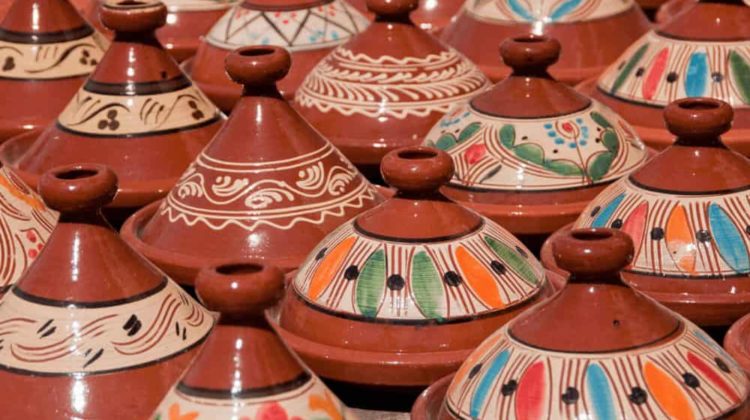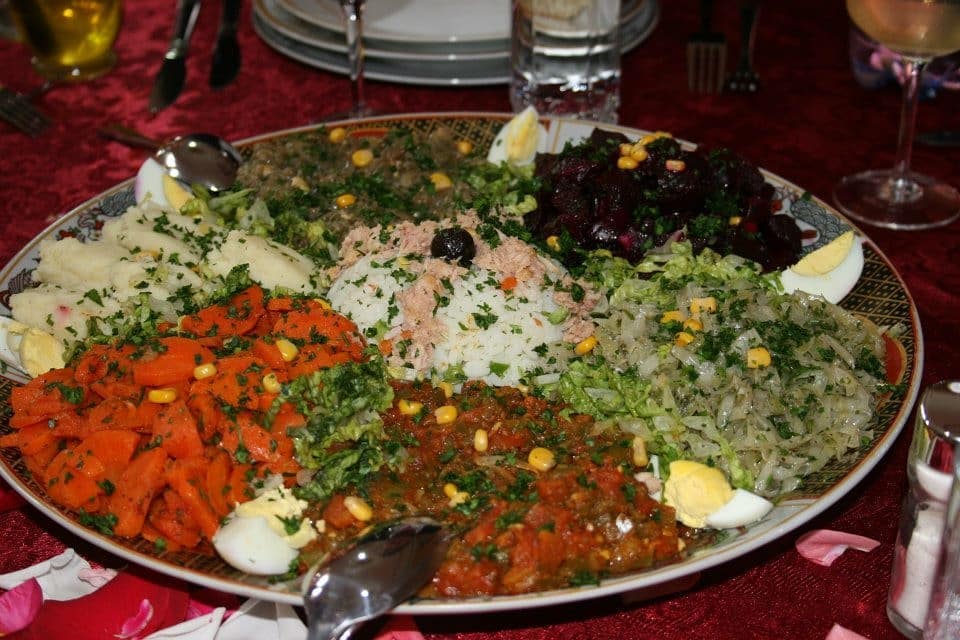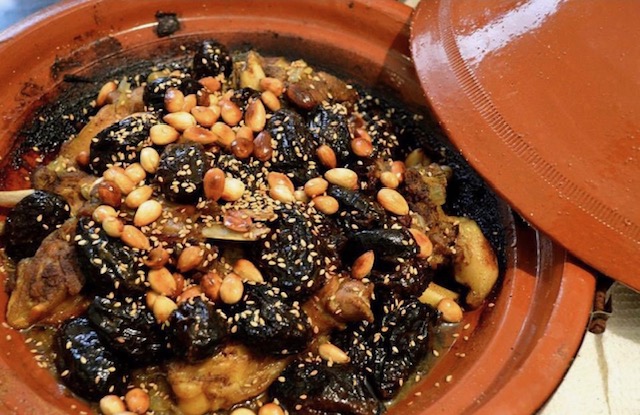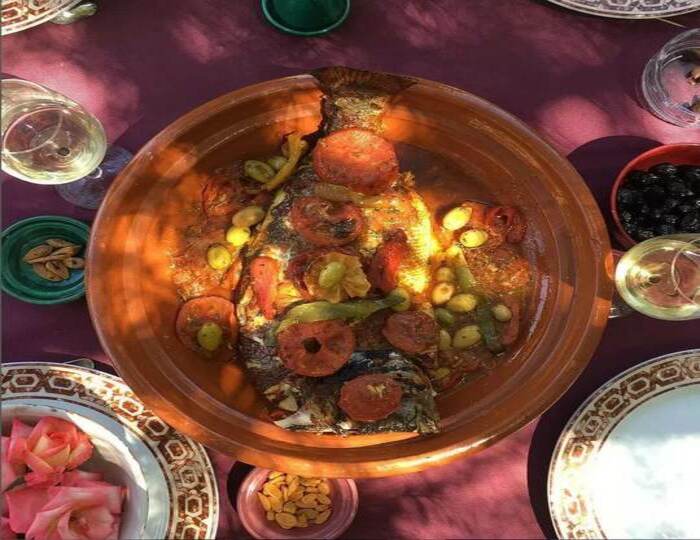Discover the magic of the Moroccan tagine, a traditional casserole dish adored by home cooks and chefs. Its iconic cone-shaped pot slow-cooks meat and vegetable stews, infusing them with rich flavors and tender textures.
The tagine’s allure has spread far beyond Morocco, finding a beloved place in kitchens worldwide.
Join us on a culinary journey to explore the tantalizing spices and mouthwatering dishes that make the tagine an unforgettable experience.
Table of Contents
What is a Tagine pot?
The tagine dish itself is a pot that has an angled cone on top to trap steam while the food cooks below. The top of the tagine is used to cover the food to cook it slowly at low temperature.

A tagine is a cone-shaped cooking vessel that comes from North Africa. Traditionally made with unglazed earthenware, tagines are used to steam, boil, or roast food.
The tagine helps to trap moisture and keep in the natural juices of the food so it doesn’t dry out during cooking.
As well as preserving moisture, this also means that flavors are concentrated making for incredibly tender meat and rich sauces.
Because of these properties, a tagine is an excellent way to cook meat, fish and vegetables. A Moroccan Tagine is a dish typically made with meat, vegetables and spices that are cooked in a casserole-like dish.
The dish is traditionally prepared with lamb or chicken, some vegetables, and spices such as cinnamon, turmeric, ginger and Ras El Hanout.
There are 2 main types of tagine design to bear in mind:
Red Handmade clay or unglazed tagine pots are the rawest kind of Moroccan tagine pots. They are made from clay and have no intricate outer design or color scheme.
They are purely functional and intended for cooking rather than for decorative purposes.
Ceramic or glazed tagine pots are typically well embellished with beautiful, ornate designs and are used to house cold dishes like salads, or other types of side dishes to accompany the main dish.
Looking for a New Tagine for Your Kitchen? Check Out These Options:
Moroccan tagine popular dishes:
The great thing about tagines is that the wide variety of recipes that can be cooked in them means you can use them for almost any occasion or dish you want to make.
Some of the most popular dishes you can make in a tagine include:
Chicken tagine with olives and preserved lemons – for a warming dish that’s great all year round and has a tangy kick to it packed full of flavor, chicken tagine is a perfect choice.
This type of dish can be prepared in advance, so you can cook it ahead of time and set it out to warm up just before serving.
Beef tagine – perfect for its filling potential, beef tagine is a hearty dish to serve at a dinner party or when you have guests over.
Its multi layered in terms of flavor profile, and is excellent with olives, carrots and potatoes.
Seafood tagine – for those who like to eat fish but don’t eat meat, a seafood tagine is a great summery addition to mealtimes.
Sea bass, king prawns and Sole are just some examples that cook very well in a tagine.
It’s simple, tasty, and can be served as both a main or side dish for a bigger meal.
Side dishes to accompany tagine
A tagine meal is often accompanied by a wide variety of salads so that guests may select from them. Among the most well-known Moroccan salads is carrot salad.

Carrots are typically boiled until soft before being tossed in a simple vinaigrette mixed with your preferred herbs and spices.
The green pepper and tomato salad is another one of the most popular Moroccan salads.
Its simple ingredients allow it to accompany a wide variety of meals.
In Morocco, it is usually served as a side dish alongside tagines or grilled foods. It is refreshing and healthy, making it a great choice for hot days.
Eggplant salad or zaalouk is made with freshly ground tomatoes and eggplant and combined to make a delicious side.
Zaalouk is a tasty and nutritious dish that can be eaten either hot or cold. It can be eaten as a dip, a spread, or a side dish, among other things.
Moroccan beet salad is a citrusy cumin-spiced salad is a great way to spice up any meal. It is bright and colorful, and a sharp purple onion provides a nice contrast.
Where to buy the Tagine:
Within Morocco:
Tagines are available in abundance throughout Morocco, with variations on design, color, size and overall quality.
The most popular cities that provide an extensive range are: Safi, Marrakech, and Fez.
But you don’t want to spend over the odds to have a decent tagine. In fact, a medium sized tagine dish to serve 4 can easily be sourced for around $30 in most souks.
The right one for you depends on your personal preferences and budget. Be sure to look around and finalize what type you would like to go for, as there are many to choose from.
Outside Morocco
You can purchase a traditional tagine online in specialist stores, but if they are hard to come across, fear not, as there are various alternatives which can work just as well.
You can use a heavy, shallow baking dish or a slow cooker if you don’t have a tagine cooking pot.
A heavy skillet can also be used, provided that you trap the heat and moisture with a tight-fitting lid or tin foil.
There are a lot of different types of tagine pots out there, so it can be tough to know what’s best for you.
Below are some popular brands which act as the best alternatives:
- Le Creuset
- Bruntmor Cast iron tagine
- Staub Tajine
- Emile Henry
A tagine is a Moroccan casserole that is perfect for slow-cooked meat and vegetable stews. You can also cook a wide variety of different dishes in a tagine including chicken, beef, vegetable, and seafood dishes.
The reason why you should use a tagine for your next Moroccan meal is because it’s a great way to make sure all your ingredients come out perfectly cooked while also getting a unique flavor.
Tagines trap steam while the food cooks below so they’re perfect for cooking meat and vegetable dishes that need to be slow-cooked.





